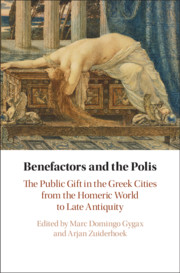 Benefactors and the Polis
Benefactors and the Polis Book contents
- Benefactors and the Polis
- Benefactors and the Polis
- Copyright page
- Contents
- Figures
- Tables
- Contributors
- Acknowledgements
- Abbreviations
- Introduction
- Part I Benefiting the Community in Early Greece
- Part II Classical Benefactors
- Part III Hellenistic Benefactors
- Part IV Benefactors and the Polis under Rome
- Chapter 8 Emperors, Benefaction and Honorific Practice in the Roman Imperial Greek Polis
- Chapter 9 Benefactors and the Poleis in the Roman Empire
- Chapter 10 Festivals and Benefactors
- Part V The Decline and Fall of Euergetism?
- Conclusion
- Index
- Index locorum
- References
Chapter 10 - Festivals and Benefactors
from Part IV - Benefactors and the Polis under Rome
Published online by Cambridge University Press: 21 January 2021
- Benefactors and the Polis
- Benefactors and the Polis
- Copyright page
- Contents
- Figures
- Tables
- Contributors
- Acknowledgements
- Abbreviations
- Introduction
- Part I Benefiting the Community in Early Greece
- Part II Classical Benefactors
- Part III Hellenistic Benefactors
- Part IV Benefactors and the Polis under Rome
- Chapter 8 Emperors, Benefaction and Honorific Practice in the Roman Imperial Greek Polis
- Chapter 9 Benefactors and the Poleis in the Roman Empire
- Chapter 10 Festivals and Benefactors
- Part V The Decline and Fall of Euergetism?
- Conclusion
- Index
- Index locorum
- References
Summary
Of all types of Greek benefaction, agonistic festivals – that is, festivals that revolved around athletic, dramatic or cultural contests – may have been the most central to the phenomenon of civic euergetism in the Greek cities of the Hellenistic and Roman period. Core questions of the chapter are: What was the significance of the fact that public festivals were paid and organised by private benefactors? Why did benefactors do this? And what was it that cities stood to gain? The main argument is that agonistic festivals were not simply an object of euergetism but also a medium through which euergetism evolved. They not only were an opportunity for elite benefactors (and athletes) to increase their prestige but were primarily mass events where benefactors and their communities were jointly involved in representing the central social, cultural and political values of the time.
- Type
- Chapter
- Information
- Benefactors and the PolisThe Public Gift in the Greek Cities from the Homeric World to Late Antiquity, pp. 243 - 264Publisher: Cambridge University PressPrint publication year: 2021


